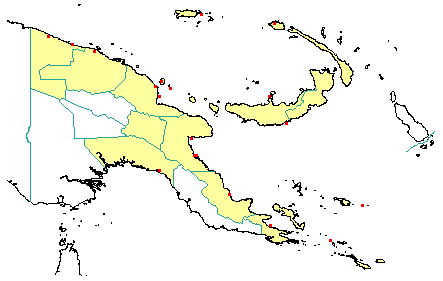
in PNGplants database
PNGTreesKey – Barringtonia asiatica (L.) Kurz |
Barry Conn (NSW) & Kipiro Damas (LAE).
Guide to trees of Papua New Guinea
Copyright held by the authors, National Herbarium of New South Wales, and Papua New Guinea National Herbarium
Preliminary Report on the Forest and Other Vegetation of Pegu, Appendix A 65 (1875)
Family: Lecythidaceae
Dicotyledon
Timber Group: Occasional timber species
Field Characters: Small sub-canopy tree (15-20 m high); Bole cylindrical (slightly irregular, 30 cm diam.); crooked (often leaning, to 5 m high); buttresses buttresses absent; spines spines absent; aerial roots aerial roots absent; stilt roots stilt roots absent; Bark dark brown, slightly rough, slightly scaly or flaky or slightly pustular, lenticels elongated vertically or lenticels irregular; Subrhytidome (under-bark) red or brown; less than 25 mm thick, 10.0-15.0; bark blaze with two layers (outer very thin); faintly to non-aromatic; pleasant (turpentine-like or legume-like); outer blaze white, pale yellow, red (patches), or green (patches), with stripes (straw-coloured), fibrous; inner blaze white or pale yellow, with stripes (straw-coloured), fibrous; bark exudate (sap) absent; terminal buds not enclosed by leaves.
Indumentum: Complex hairs absent; stinging hairs absent; mature twig indumentum (hairs) absent.
Leaves: Leaves spaced along branches, sub opposite (in pairs, opposite one another on the branchlet) or spiral (leaves occurring singly at a node and arranged spirally up the branchlet), simple (a leaf composed of a single blade); petiole absent (lamina decurrent); leaves broadest above middle, 16.0-(new growth)-38.0 cm, 8.5-15.0 cm; symmetric, entire, not dissected or lobed, sub rounded or obtuse, venation pinnate, secondary veins open, prominent, intramarginal veins absent; leaves lower surface pale green (dull to sub-glossy), upper surface green (dull to sub-glossy), indumentum (hairs) absent; absent; domatia absent; stipules absent.
Flowers: Inflorescence terminal, flowers on an unbranched axis or flowers on a branched axis, cones absent; flowers bisexual, stalked (40-50 mm long), flowers with one plane of symmetry, 90.0-150.0 mm long, diameter large (more than10 mm diam.) (90-150 mm, including. anthers); perianth present, with distinct sepals and petals whorls, inner perianth white or cream-coloured; 5, free; stamens 100 (many; white basally, red distally), present, free of each other, free of the perianth; ovary inferior, carpels joined (when more than one), locules 1; styles solitary, 1.
Fruits: Infrutescence arranged on unbranched axis or arranged on branched axis, fruit 100.0-140.0 mm long, 100.0 (c.) mm diam., green or brown (when mature 4- or 5-angled), not spiny, non-fleshy (corky tissue surrounding the seed), simple, indehiscent, drupe; seeds 1 (surrounded by fibrous fruit wall), much more than 10 mm long (60-80 mm long), not winged, broad (as wide as long) or usually narrow (longer than wide), seed more than 10 mm diam. (40-50 mm wide).
Distribution: West Sepik, East Sepik, Madang, Morobe, Eastern Highlands, Gulf, Northern, Milne Bay, Papuan Islands, New Britain, New Ireland & Manus.
 | Botanical records in PNGplants database |